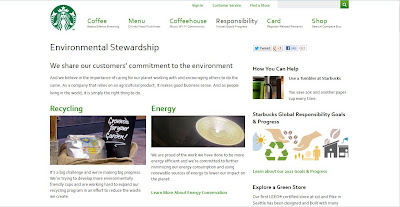Starbucks has “always believed that businesses can - and
should - have a positive impact on the communities they serve.” No other words describe quite as well just
exactly what the Responsibility subpage and subpages are concerned with. This is a very broad area though, and
Starbucks quickly narrows the field by indicating textually that they are
interested in “Community, “Environment,” “Sourcing,” and “Wellness”
responsibility. The Responsibility
subpage makes this known immediately through listing the four responsibilities
they are dedicated to. There is a sense
of credibility here, because naturally, only the company can tell the reader
what they care about. Also, credibility
is built as the reader explores each area and their respective subpages. These subpages explain specific details that
Starbucks cares about. On the
Environment subpage, the text lists “Recycling,” “Energy,” “Water,” “Green
Building,” and “Climate Change.” Each
category has its own subpage informing the reader what Starbucks has done with
or about that specific concern. Also,
credibility comes in the shape of the reliable blog on the bottom left of the
page. This time posts are concerned with
topics such as climate change and recycling and authored by people within the
company who work directly with these issues.
The blog continues to add credibility through listing posts about each
of the four original Responsibility categories.
The big four responsibilities and their respective
sub-responsibilities appeal to an audience that cares about corporate
responsibility. Starbucks is tapping
into the social trend of concerned consumerism.
This text exploits that trend for the company’s benefit, while also legitimately
providing the information readers value.
The text appeals to the reader through specific textual information and
images showing exactly what Starbucks cares about and has done. Furthermore, in a move to invite participation,
Starbucks encourages readers to help out as well by purchasing a reusable and
refillable tumbler to avoid unneeded waste.
And, as usual, readers have social media links allowing all this
information to be easily shared.

No comments:
Post a Comment